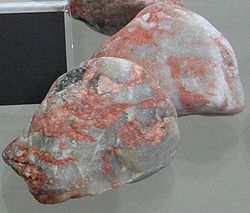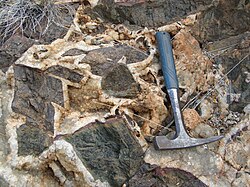Pegmatite
Pegmatite is the name for the coarse-grained variety of igneous rock . The typical grain size is more than one centimeter, but crystals with sizes well over one meter are not uncommon.
features
The vast majority of pegmatites are granitic or alkaline- granitic in composition and consist mainly of the minerals quartz , feldspars ( orthoclase , microcline and high-sodium plagioclase ) and mica such as biotite , muscovite or lepidolite . Mafic and syenitic pegmatites are of minor importance in terms of quantity, but are partly economically very important . Pegmatites typically form duct- shaped or lens-shaped rock bodies with thicknesses in the order of a few decimeters to a few tens of meters. The corridors can be zoned internally, i.e. certain minerals occur more at the edge, others in the core of the pegmatite.
Emergence
Melts that lead to the formation of pegmatite occur when, during the crystallization of a pluton, incompatible elements such as lithium , rare earths , thorium or uranium , i.e. components that generally do not fit into the crystal structure of the common rock-forming minerals and at the same time highly volatile substances such as water, phosphorus , boron or accumulate fluorine in the residual melt. A similar process takes place in the partial melting of rocks during high-grade metamorphosis.
Due to the presence of the volatile constituents, on the one hand the melting point is lowered considerably, so that the melt only solidifies at a temperature of around 450 ° C, on the other hand it becomes more liquid, i.e. that is, the viscosity is significantly reduced. Because of these properties, the melt can move along fissures deep into the surrounding rock, often many kilometers.
classification
(Granitic) pegmatites can be divided into different classes based on their chemical composition, the mineral content and their formation environment ( metamorphic facies ).
- Abyssal pegmatites: Formed by anatexis in an amphibolite to granulite facial environment and rarely contain minerals of the elements U , Th , Zr , Nb , SEE . Countless pegmatites of this class can be found in the highly metamorphic areas of the Precambrian shields worldwide.
- Muscovite pegmatites: Formed by anatexis under amphibolite facial conditions. They occasionally contain Li , Be , Ti , Nb , Ta , U , Th and SEE minerals and are a source of industrial muscovite production.
- Rare element pegmatites: Formed by the progressive fractionation of granitic magmas in Upper Greenschist-Lower Amphibolite facies. Often minerals of Li , Rb , Cs , Be , Ga , SEE , Sn , Ti , U , Th , Hf , Nb and Ta . Depending on the mineralogy, rare element pegmatites are further subdivided into 1) rare earth pegmatites ( allanite , monazite , gadolinite ); 2) beryl pegmatites ( beryl , columbite ); 3) Complex (Li) pegmatites ( spodumene , petalite , amblygonite , lepidolite ); 4) albite-spodumene pegmatites (spodumene); 5) Albite pegmatites .
- Miarolitic pegmatites: Form pockets in hypabyssal plutons and in a sense represent a low-pressure variant of the rare element pegmatites.
use
Industrially important minerals and rare elements such as boron, beryllium and lithium are extracted from pegmatites . Sometimes there are also gemstones such as topaz , smoky quartz , various tourmalines or beryl . Due to their vein-like occurrence, the unevenly distributed mineralization and the mostly small volume, pegmatites only play a minor role as deposits in a global comparison . Mineral collectors value pegmatites because of their occasionally very rare and / or extraordinarily large minerals.
Important examples are the two kilometer long and 45 to 60 meter thick Bikita pegmatite in Zimbabwe , which is one of the largest deposits of lithium, cesium and beryllium in the world. In the Altai Mountains in Mongolia there is a 20 to 70 kilometer wide swarm belt in which numerous pegmatite fields and swarms line up over a length of around 450 kilometers. Here, deposits of rare earth metals in particular are mined. The pegmatites of Bancroft ( Ontario ) and the huge deposits of Rössing in Namibia are mined particularly because of their uranium content.
See also
- List of rocks
- Pegmatite Peak , mountain in Marie Byrd Land, Antarctica
- Pegmatite Point , headland on the Amundsen Coast, Ross Dependency, Antarctica
literature
- D. London: Pegmatites . Canadian Mineralogist Special Publication 10, 2008, 347 pp.
- D. London & DJ contact: Granitic Pegmatites: Scientific Wonders and Economic Bonanzas . Elements 8 (4), 2012, 257-261.
Web links
- Mineralogical Society of America [MSA]: Pegmatite Interest Group (English)
- Giant crystals in Pegmatiten (English)
- Pegmatite in the Mineral Atlas
Individual evidence
- ↑ " coarse-grained facies of any type of igneous rock " RW Le Maitre (eds.), A. Fahrtisen, B. Zanettin, MJ Le Bas, B. Bonin, P. Bateman, G. Bellieni, A. Dudek, S. Efremova, J. Keller, J. Lameyre, PA Sabine, R. Schmid, H. Sørensen AR Woolley: Igneous rocks. A classification and glossary of terms. 2nd edition, Cambridge University Press, Cambridge 2002, pp. 1-236.
- ↑ D. London: Granitic pegmatites: an assassment of current concepts and directions for the future. In: Lithos, 80, 2005, pp. 281-303.
- ↑ P. Černý Geochemical and petrogenetic features of mineralization in rare-element granitic pegmatites in the light of current research . In: Applied Geochemistry, 7, 1992, pp. 393-416.




